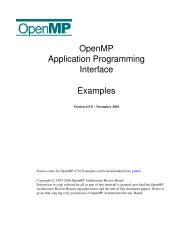D2 3 Computing e-Infrastructure cost calculations and business _models_vam1-final
D2 3 Computing e-Infrastructure cost calculations and business _models_vam1-final
D2 3 Computing e-Infrastructure cost calculations and business _models_vam1-final
You also want an ePaper? Increase the reach of your titles
YUMPU automatically turns print PDFs into web optimized ePapers that Google loves.
e-‐FISCAL: www.efiscal.eu <br />
EC Contract Number: 283449 <br />
utilisation rate of 71.3%. The utilisation rate in the e-‐FISCAL project has been calculated by taking into account <br />
yearly logical wall clock time <strong>and</strong> available CPU cores at the end of the period (i.e. 31/12/2011). This assumes that <br />
the number of CPU cores reported at the end of the period is available throughout the year. If this is not the case <br />
(e.g. because of an infrastructure upgrade towards the end of the year), the utilisation rate calculated is <br />
underestimated. <br />
Other interesting findings are the high numbers of depreciation rates for the hardware (average 5 years), the <br />
quite good rates of PUE (of around 1.5 median value) <strong>and</strong> the percentage of electricity <strong>cost</strong> (around 15% median <br />
value of all <strong>cost</strong>s). <br />
51% of total <strong>cost</strong>s (median values) is dedicated to personnel <strong>cost</strong>s. It is expected that the personnel <strong>cost</strong>s for a <br />
very large computing centre (in the order of 100,000 cores) can show economy of scale if compared to the same <br />
capacity distributed in smaller sites that are federated together. We discuss this issue in more depth later on. <br />
However, the fact that staffing represents a very significant <strong>cost</strong> category was expected. Intersect 360 in both its <br />
reports of 2011 <strong>and</strong> 2012 (Intersect 360, 2011; 2012) mentions that the staffing represents 23% of top–level <br />
budgets. This amount in not directly comparable to e-‐FISCAL due to the different methodology employed <br />
(Intersect 360 conducts a census on budgets <strong>and</strong> as such the total acquisition budget of hardware-‐<strong>and</strong> not its <br />
depreciation-‐ is included in the 100% calculation); however, the magnitude is similar. Moreover, they claim that <br />
they expect to see in the near future an increase on the money spent on people to manage <strong>and</strong> maintain systems, <br />
as the computers <strong>and</strong> overall IT architectures become more complex. <br />
Finally, our results seem to coincide with earlier findings found in literature as shown in Table 3. However, while <br />
other studies concentrate only on site or centre, e-‐FISCAL is the first <strong>cost</strong>ing study that comes up with conclusions <br />
resulting from an extensive synthesis. <br />
Reference Cost per core <br />
Comments <br />
hour <br />
Hawtin et al. (2012) €0.075 Study for JISC UK -‐ Differences between <br />
institutions reviewed <br />
US DoE -‐ Magellan <br />
report (2011) <br />
€0.015 Hopper system – National Energy Research <br />
Scientific <strong>Computing</strong> Centre-‐ including storage <br />
sub-‐ system <br />
Smith (2011) €0.031 Purdue campus, USA <br />
University of <br />
€0.020 Hyak cluster, USA <br />
Washington <br />
Cohen <strong>and</strong> Karagiannis <br />
(2011) <br />
€ 0.09 – <br />
€ 0.14 <br />
Stratified sample of EGI centres -‐ Assuming <br />
60% utilization ratio – storage <strong>cost</strong> included, <br />
(<strong>cost</strong>s refer to 2009) <br />
Cohen <strong>and</strong> Karagiannis <br />
(2011) <br />
€0.08 – <br />
€0.10 <br />
Stratified sample of EGI centres -‐ Assuming <br />
60% utilization ratio – storage <strong>cost</strong> excluded <br />
(<strong>cost</strong>s refer to 2009) <br />
Table 3 – Literature review summary in relation to Cost per core hour or Cost per core hour<br />
Option 2: Basic Case Split: We also run the e-‐FISCAL <strong>cost</strong>ing model by using as inputs the average <strong>and</strong> the median <br />
values of all necessary input data from the HPC <strong>and</strong> the HTC e-‐FISCAL sub-‐samples (e.g. the average <strong>and</strong> the <br />
e-‐FISCAL : Financial Study for Sustainable <strong>Computing</strong> e-‐<strong>Infrastructure</strong>s <br />
Deliverable <strong>D2</strong>.3 – <strong>Computing</strong> e-‐<strong>Infrastructure</strong>s <strong>cost</strong> estimation <strong>and</strong> analysis – Pricing <strong>and</strong> <br />
Business <strong>models</strong> <br />
45




